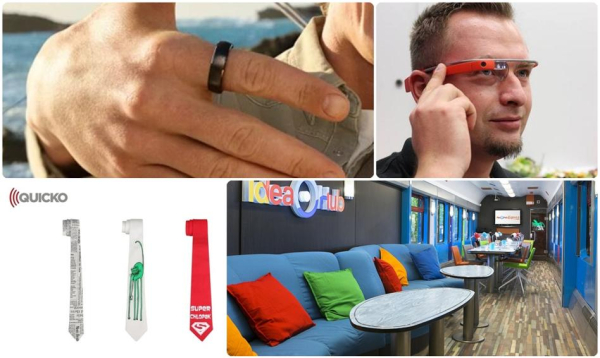Bank Pekao wants to ring 70 thousand customers. Literally – it will offer them a ring for contactless payments. Will the solution catch on? It is hard to say at the moment, because smartphones dominate the market. We took the opportunity to check what other banking innovations have been tried to be implemented in recent years, but ultimately failed.

In a few days, Bank Pekao will introduce a ring for contactless payments (Peoring) to its offer. It will work in a similar way to various gadgets that allow contactless payments – just bring your hand close to the POS reader and make a transaction. Up to PLN 100, you do not need to enter your PIN, above PLN 100, the code is required. The bank has ordered 70,000 rings (this is probably the largest implementation of this service in Europe) and hopes that it will be able to convince customers to buy them. The bank's representatives also hope that the pool of rings will be exhausted quickly and another order will have to be placed.
I will be watching with great interest how Pekao customers adapt the wedding ring. Especially since the idea of paying with a ring is not new at all. We wrote about the first implementations of this type on Bankier.pl and PRNews.pl a decade ago. And Visa even equipped Olympic athletes taking part in the Rio Games (2016) with such gadgets. However, this solution has not been adopted on a mass scale so far. What's more, contactless payments in watches have not been adopted on a mass scale either. The market seems to be dominated by smartphones and traditional cards. But maybe this time we will be able to pave the way and put rings on tens of thousands of the bank's customers?
See alsoHow artificial intelligence will affect the work of accountants
The new implementation of Bank Pekao prompted me to look into the text archive and take a look at several bank innovations that did not survive the test of time. Because payment rings are not the only curiosity that they tried to convince customers to buy in recent years. Some of these innovations did not survive the test of time.
Suit and tie for payment
Although it sounds funny today, there was a time when bankers tried to sew payment chips into various items of clothing. For example, in 2014, the Australian Heritage Bank, in cooperation with MJ Bale and Visa, developed a prototype of a suit for contactless payments. The payment chips are located in the cuffs of the jacket. In turn, Quicko tempted women with necklaces with a contactless payment function, and for men it offered ties with a sewn-in NFC module. There were also other gadgets – for example, key rings (mBank or PKO BP). You can find photos at this link.
Contactless payment stickers
Before contactless payments became a permanent fixture on our smartphones thanks to Apple Pay and Google Pay, other payment methods were experimented with. A decade ago, banks were issuing cards in the form of stickers that could be attached to the back of a phone, for example. Even if our smartphone did not support NFC technology, there was nothing to stop us from holding our phone up to the terminal and making contactless payments. Ultimately, however, this solution was abandoned, although some banks still offer sticker cards.
Separate payment apps for each store
In 2013, I wrote a text titled “The Wild West of m-payments.” It was a turbulent period in the history of Polish payment innovations. After the debuts of the first mobile banking applications for iOS and Android smartphones, there was a flood of applications allowing for making payments. Each of the creators pushed their own system. Bank Pekao wanted to develop payments with Peopay codes, PKO Bank Polski pushed for payments with codes in IKO (ultimately, this solution survived to this day in the form of Blik), and fintechs implemented their own applications. Who today remembers Codi Pay, Rock Pay, Mass Pay and other similar ones?
Mobile payments at Biedronka
You may remember that some stores implemented separate applications that allowed payments only in one network. A prime example was iKasa from Biedronka, i.e. mobile payments, which appeared in this chain of stores even before cards. The chain resisted implementing card acceptance for a long time, because it involved additional costs (interchange), and this could lead to an increase in prices in stores. Ultimately, however, they capitulated and gave up on iKasa – today, you can pay with cards and smartphones in Biedronkas. But there are still stores that rely on their own methods – e.g. Żabka (Żabbka Pay) or some petrol stations (e.g. Orlen Pay).
Bank Account Management Through Glasses
There was such an idea. In 2014, Bank Millennium invited me to the premiere of an application developed for Google Glass. At the time, I wrote: “Google Glasses are operated using voice commands and touch. The menu is displayed on the screen on the right eyepiece. It only takes a few moments to get used to the device. To launch the Millennium application, we use the voice command “Start Millennium”. After launching, we are presented with a start screen where we must enter the PIN. Of course, we do not enter the password aloud, but we operate it by touching one of the earpieces. There is a sensor there, which we use to operate the application “manually”.
The solution obviously didn't catch on, and a year later Google announced that it was abandoning further work on the device. As a curiosity, the Millennium app for the Sony smartwatch was also presented during the press conference. It no longer works in its current form, but eventually the watches caught on in banking (although not on a mass scale either).
Bank on TV
And while we're on the subject of glasses, let's not forget about the TV. In 2013, Bank Zachodni WBK (today Santander Bank Polska) came up with the idea of preparing an application for handling online banking on Samsung's Smart TV. The plans were ambitious – the rapid development of technology would eventually allow for making purchases directly through the TV (e.g. while watching commercials). However, the technology did not advance that much and eventually the development of this application was abandoned. The solution was more of an industry curiosity.
ATM withdrawal using fingerprint
There was a period in Polish banking when the idea of using biometrics in ATMs was being pushed intensively. The idea was that instead of making a withdrawal with a card or Blik, the user would place their finger on a special reader in the device and thus authorize the withdrawal of cash. Several cooperative banks even decided to implement this solution. Ultimately, however, there was a problem with extending the service to other institutions. This problem may not have resulted from the need to adapt the machines to withdrawals with a finger, but from the need to create biometric databases of customers. Because a fingerprint had to be linked to a specific account, bank, etc. Perhaps the solution still works locally somewhere, but some banks have long since abandoned it.
Mobile ATMs, self-service kiosks and a branch in a wagon
Banks had more eccentric ideas. Institutions belonging to the Getin group were particularly keen on bold innovations. For example, Getin Bank promoted self-service kiosks that were to replace bank branches (so-called Getin Points). They were equipped with screens, ATMs and similar gadgets. You could open an account there, order a transfer or perform cash operations at an ATM. Ultimately, the solution did not go beyond the pilot phase.
Another interesting thing was the mobile cash deposit machines of Idea Bank, which were operating for some time. They were electric BMW cars with a cash deposit machine installed. The idea was for such a vehicle to come to entrepreneurs at the end of the day and accept cash from the takings. After some time, however, the bank withdrew from this solution. Another interesting thing about Idea Bank was a bank branch installed in a train carriage.
Display Cards with Diamonds and Perfumes
A separate text could be written about payment cards. Before smartphones became widely available, banks were convinced that innovative payment cards could be one of the competitive advantages. So they introduced new solutions, such as a card with a display and keyboard, or metal cards. But bankers had even more ideas. I was the only journalist who had the opportunity to visit the Oberthur Technologies card personalization center, which produces cards. I was then shown cards that glowed in the dark, scented, folded, had unusual shapes, or even cards encrusted with diamonds. Some of these inventions made their way to Asian markets.
The beginning of the second decade of the 21st century was full of interesting innovations in Polish banking. Unfortunately, many of them did not survive the test of time. Later, the market began to unify – subsequent solutions disappeared, and the banks' offers became more and more similar to each other. Today, every bank offers standard payment solutions – Apple Pay, Google Pay and Blik. Is Bank Pekao's bold move a sign of change and a chance for more interesting implementations? Time will tell. We will return to the subject.






